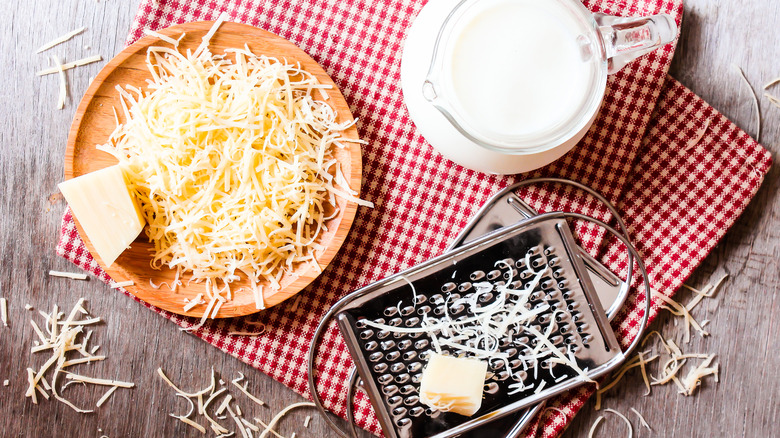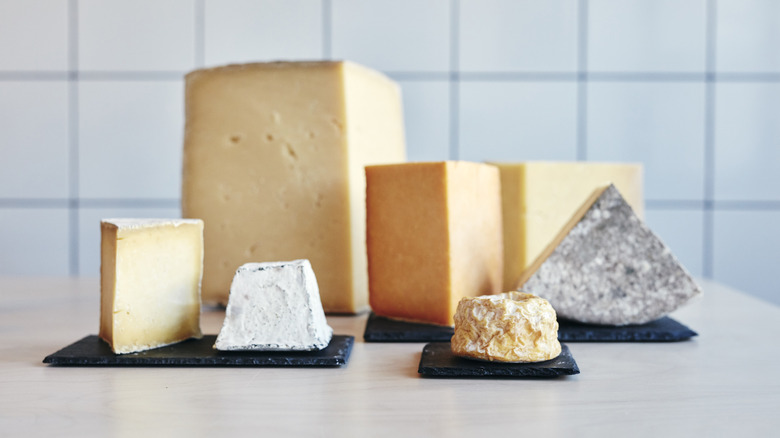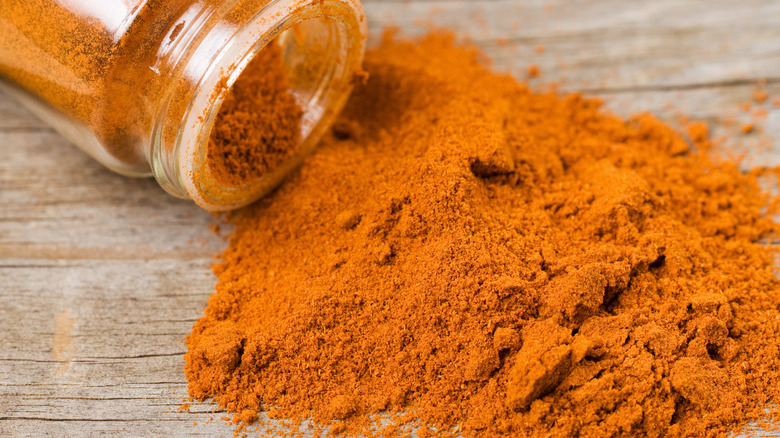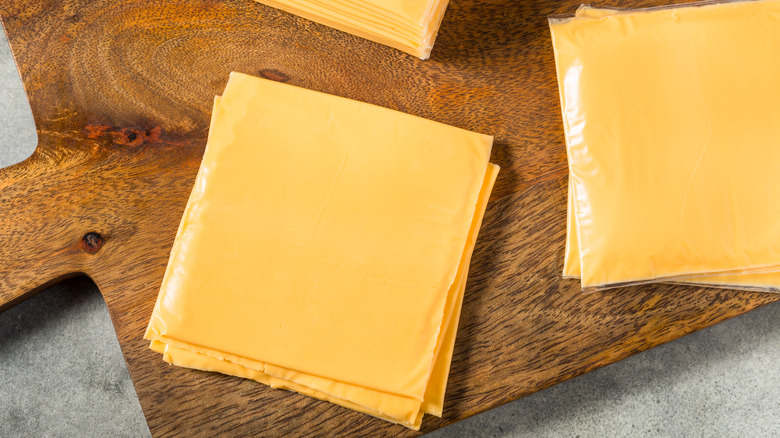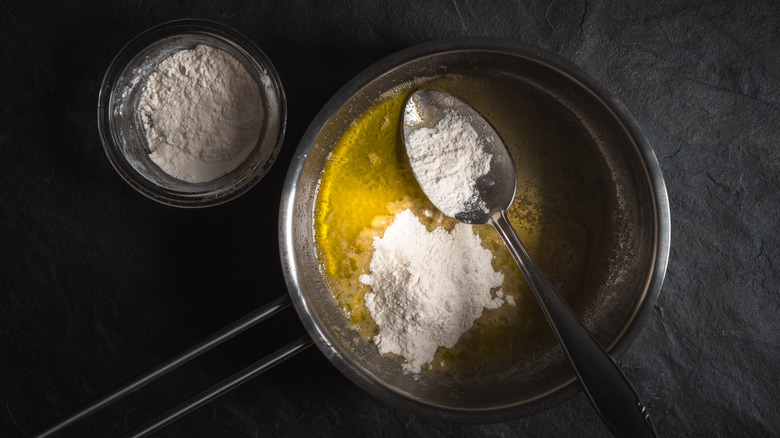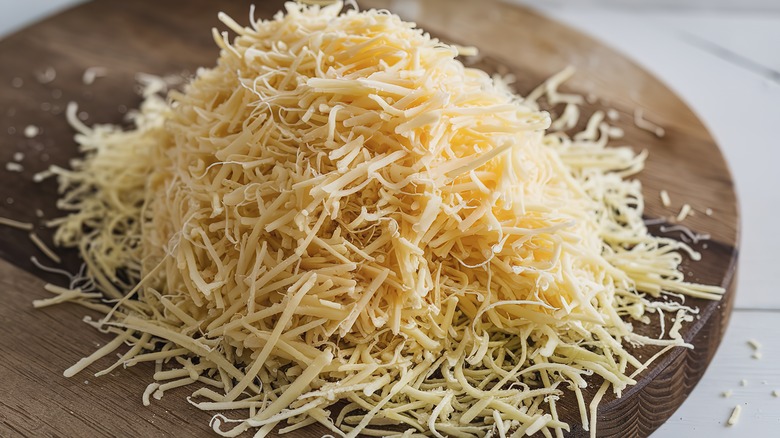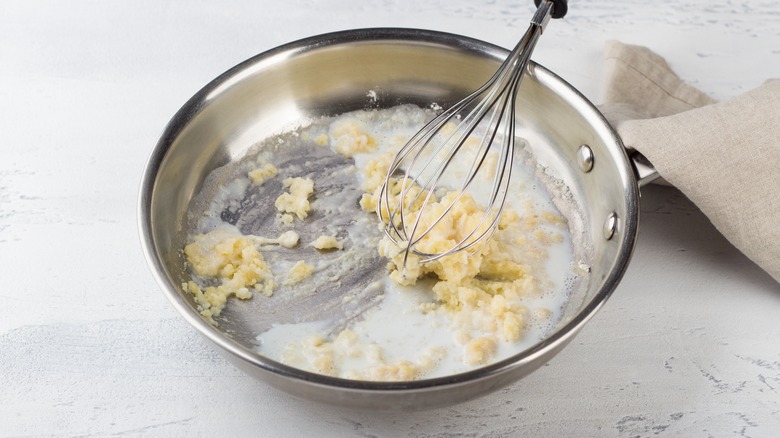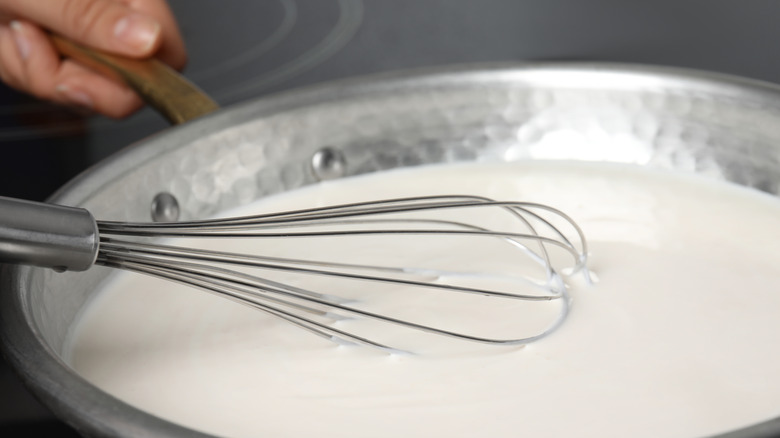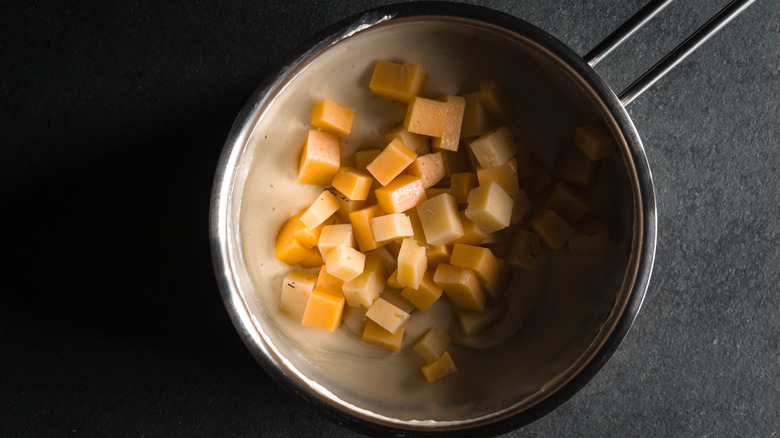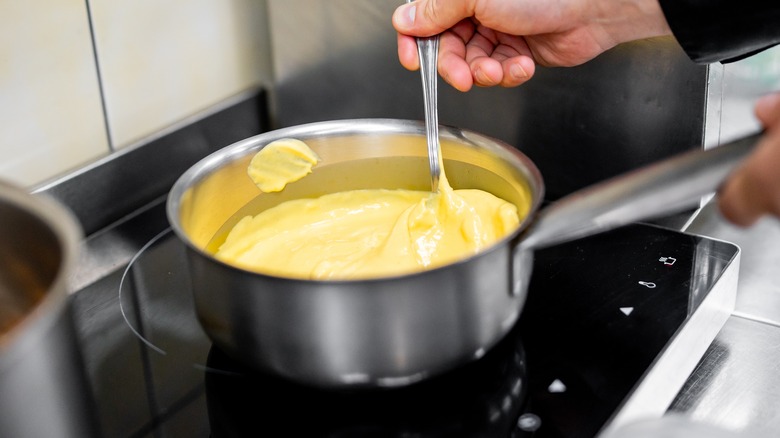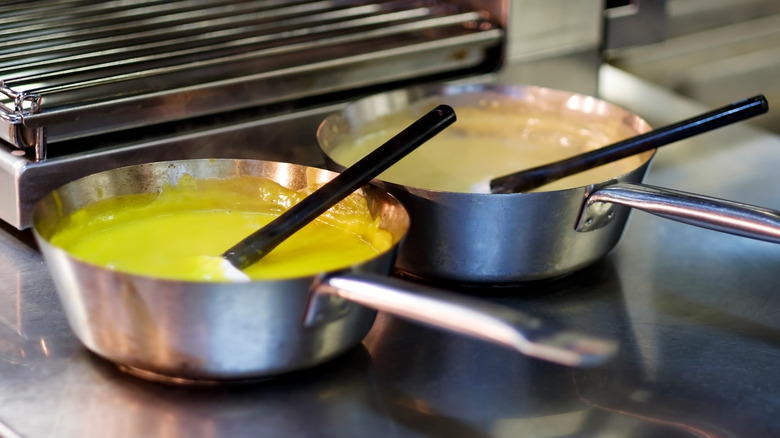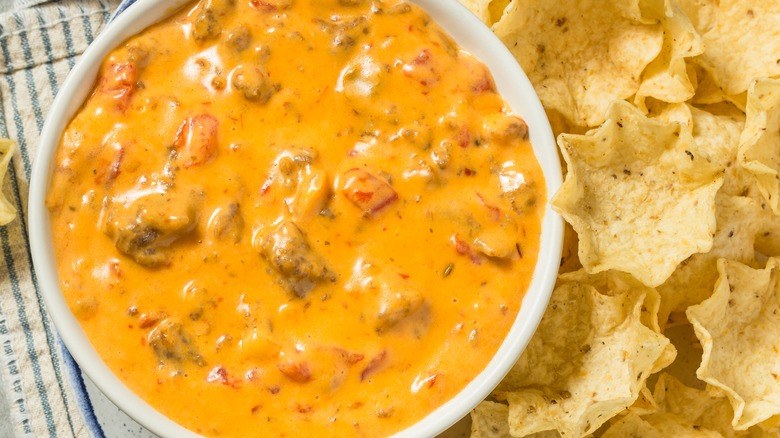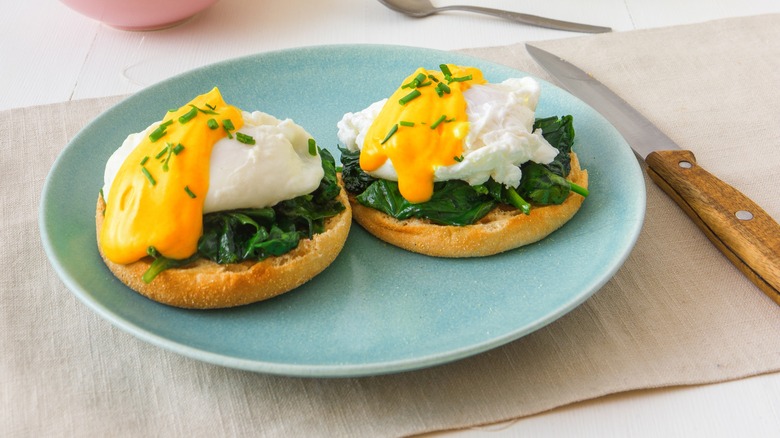12 Mistakes To Avoid When Making A Cheesy Sauce With Milk
To many, cheese sauce is a staple of American cuisine. Whether thickly coating elbow-shaped macaroni, drizzled across steamed vegetables, or slathered over tortilla chips embellished with beans, onions, and bacon, cheesy sauces are beloved by all. Just how is this versatile sauce usually made? When you whittle it down, a cheese sauce with milk is made in three steps. First, you prepare the roux. Next, you add milk to craft a béchamel, the creamiest of all the five mother sauces of French cuisine. From here, cheese is added, leading to cheese sauce. If you add sharp cheddar, you'll have what most think of as a classic cheese sauce. Grate in Gruyère and you'll end up with a Mornay sauce, perfect for topping fish or poached eggs. Toss in mozzarella and Parmesan and you've got an Italian cheese sauce that's amazing paired with pasta.
Sounds simple, doesn't it? While a cheese sauce made with milk only requires three steps at its most rudimentary, there are still plenty of mistakes to be made along the way. Cheesy sauces are especially prone to curdling or splitting, lending them an unevenness that is visually unappealing and oddly textured. They can also be too thin or too stringy. Worst of all, you can do everything right and still end up with a bland, flavorless cheese sauce. What is one to do? You can start by avoiding the common pitfalls. The key to crafting a well-textured, richly-flavored cheese sauce lies in choosing the right ingredients, maintaining a close eye on the cooking process, and most important of all: timing.
Selecting the wrong ingredients
When crafting a great cheese sauce, one should always start off on the right foot — and to do so, you have to come with the right ingredients. No amount of skill or expertise can save your cheese sauce if you begin with faulty building blocks. First and foremost, never buy pre-grated cheese for a cheese sauce. There are two reasons behind this. Primarily, you should always grate cheese yourself for the freshest flavor. Secondly, pre-shredded cheese is full of additives that can negatively impact a cheese sauce. These pre-grated cheeses are usually coated with anti-caking agents to prevent the shreds from clumping and sticking together. These pesky anti-caking additives like cellulose or calcium sulfate can lend an awkward texture to your cheese sauce, affecting its smoothness and leaving it grainy.
What sort of cheeses should you buy? The best cheeses for sauce are those that melt easily, resulting in a nice, ooey gooey texture. Great melting cheeses include high-moisture cheeses such as mozzarella, Gruyère, American cheeses, and Jack cheeses like Colby Jack and Monterey Jack. Aged cheeses like Parmesan can be used as well, but may require a starch to help them melt reliably, as their moisture content is lower. This can be added by coating the grated cheese in cornstarch. Whatever you do, steer clear of acid-set cheeses like ricotta, paneer, queso fresco, and fresh goat cheese. These cheeses do not melt and will not work in cheese sauces.
Skipping the seasoning
No matter what you're cooking your cheese sauce for, you're going to require something else than cheese to flavor it, otherwise the sauce may taste bland. Crafting a cheese sauce for pasta? Consider adding smoked paprika, garlic powder, or nutmeg. Making mac and cheese? Try dried mustard powder or even a spoonful of dijon as a stunning secret ingredient to make your macaroni and cheese shine. Wielding that sauce for nachos and chip-dipping? For a delectable queso cheese sauce, you might try adding cilantro, green chilis, tomatoes, or diced jalapeños.
Cumin can also lend sauces a warm and earthy feel. A pinch of cayenne pepper or the addition of buffalo sauce are great companions to give cheese sauces some kick. Wondering when to add your spices? Most recipes will call for you to do so when you add the cheese at the very end.
Only buying one cheese or low-quality cheese
Great cheese sauces are rarely made from one cheese and one cheese alone. Many Mornay sauces are made from Gruyère and Parmesan, while some mac and cheese recipes are derived from up to four different cheeses. For a stunning cheese sauce for pasta, try blending different flavors, like creamier cheeses with earthier ones. Whole milk cheeses that easily melt are best for cheese sauces. For nacho cheese, Monterey Jack, mild or medium cheddar, and Colby Jack are great. American cheese will lead to a milder sauce, while sharper cheddars are great for crafting bolder flavors.
Mild and medium cheddar are usually aged a few months, consequently having more mellow flavors. By contrast, aged cheddar is often aged anywhere from 12 to 18 months, while extra sharp cheddar is aged 18 months onwards, having more time to develop stronger flavors as a result. It's important to be aware that a cheese's flavor will be somewhat diluted by the addition of milk, so although you may prefer mild cheddar most of the time, a stronger aged cheddar may be more appropriate for a cheese sauce.
Another important consideration is the quality of the cheese. You're not going to shape a spectacular cheese sauce from using bland or low-quality cheese. For a sensational sauce experience, stay away from processed cheeses and opt for those of higher quality, such as those labeled grass-fed, pasture-raised, or farmstead. These cheeses tend to possess more flavor and outshine ones that aren't cultivated from grass-based milk. Farmstead indicates the cheese was made where the animals were raised, often signifying a fresher product.
Undercooking or overcooking the roux
A great cheese sauce all begins with the roux. Most often made with equal parts butter and flour, it is important to heat the roux enough to remove the raw flour taste, but you don't want to cook it too long and darken. A darker roux is best suited to robust gravies and brown sauces, not the light flavor many prefer in a cheese sauce. To make a light roux, set your stove to medium-low heat, and liquify the butter (or another fat). Sprinkle the flour over the top. Next, use a wooden spoon to stir the two continuously for three to five minutes.
Once finished, you should notice the roux has puffed up somewhat. Now, you can immediately move onto making a béchamel by adding milk. Can't have gluten? A gluten-free roux can be made with gluten-free flour, cornstarch, arrowroot powder, tapioca starch, or rice flour.
Not adding enough cheese
Skimp on the cheese and your cheesy sauce may end up too thin. If you're not using a recipe, a good rule of thumb is to use as many cups of cheese as cups of milk. Still certain cheese sauce recipes exceed this measurement, so feel free to add more cheese as needed. Be wary of adding too much, however, as this can lend your sauce a stringy texture. You will likely find that sauces made with young cheeses require more cheese due to their milder flavor, while those made with stronger-flavored aged cheeses won't need nearly as much.
The only trouble here tends to be that aged cheeses aren't as reliable melters as young cheeses as they have less moisture. If you're adding a cheese like Parmesan or Pecorino Romano that may have difficulty melting smoothly, consider adding a starch to stop the fat from coalescing, such as cornstarch. An acid, like white wine, may also hinder a cheese sauce from becoming stringy, hence why white wine is often added to fondue recipes. You can also add a little sodium citrate to help harder cheeses melt smoothly.
Making a lumpy béchamel
A good white sauce should be smooth, gooey, and free of clumps. Make a chunky béchamel and you'll likely end up with a clumpy cheese sauce. A lumpy béchamel can result from several missteps, including the wrong ratio of butter to fat in your roux, adding milk too quickly to the roux, or not whisking the mixture appropriately. Likewise, a béchamel made with skim milk is more likely to curdle due to lack of fat, so be sure to opt for milk with a higher fat content, as well like whole milk.
To avoid any lumps forming in your béchamel, always measure your butter and flour (2 ounces flour and 2 ounces butter is an easy measurement to use). Also, try adding ½ cup of cold milk at a time and whisk continuously. This will help prevent lumps from forming because you added milk too quickly. Make sure you cook your béchamel until it has appropriately thickened, as well, keeping the heat on low. A correctly thickened béchamel should coat the back of a spoon. If it slides off easily, it needs more time. Oftentimes, this takes around five to seven minutes.
Under-stirring during cooking
It should not be surprising to learn that stirring is an integral part of making any sauce, but with cheese sauce it is especially important. Don't stir your roux enough and it may burn. Likewise, under-whisk the milk as you add it and it won't incorporate smoothly. Using a figure-eight stir or whisk pattern is a tried and true method to evenly cook a roux and prevent lumps from forming. This figure-eight pattern is also wonderful for stirring in your cheese, and is commonly used in fondue-preparation to prevent the wine and cheese medley from breaking.
When whisking your béchamel, pay close attention to your technique. Try to ensure the whisk touches the bottom of the saucepan and stir the sides well to stop the sauce from catching. As milk is added, you should continue whisking until the sauce is smooth and thick. If lumps form, try to push them against the side of the vessel to break them up.
Adding the cheese too fast
You've cooked your roux to the perfect state, followed by adding milk slowly and steadily to make a velvety-smooth béchamel. Don't biff it now by plopping that cheese all in at once — otherwise those dreaded lumps may appear. Just like the milk, grated cheese should be added incrementally and stirred in so it doesn't clump. To avoid a ruinous gloopy nightmare, add your grated cheese gradually, stirring until it has melted before adding more. Additionally, be sure your cheese is grated well enough so it melts quickly. Different cheeses may require different levels of grating.
For semi-hard cheeses like Gruyère, cheddar, fontina and Jack, using the larger holes on your box grater is fine. The smaller shredding holes are better for Asiago, Parmesan, and Pecorino Romano, which are harder to melt. Be sure to stir as you add your cheese to help it incorporate.
Overcooking the cheese sauce
Ever end up with a grainy-texture in your sauce? This can happen due to a number of reasons, but the most likely culprit is overheating the sauce. Heat a cheese sauce too long and it might break or curdle. Remember, a sauce with dairy should never be permitted to boil. For this very reason, many truly dedicated chefs claim a griddle to be the best way to cook a béchamel sauce, rather than over direct heat. Regardless of whether you opt for the griddle or the stovetop, save yourself from the dire fate of a grainy sauce and remove the mixture from heat as soon as the desired consistency is achieved.
Many choose to remove the sauce from heat before adding the cheese. However, if the cheese is not melting appropriately, you may turn the heat back on low, but be sure to remove the sauce from the heat as soon as your cheese melts. Additionally, overcooking the cheese sauce is less likely to happen if your cheese is adequately shredded. Abstain from adding cubed cheese to your cheese sauce, always opting for grated instead. Cubed cheese may take too long to melt resulting in a sauce that curdles before the cheese has reached the desired consistency.
Making the cheese sauce too soon
A sauce left out at room temperature too long can break, so always save the cheese sauce for last. You'll also enjoy the added benefit of not having to reheat the sauce. If making mac and cheese, the pasta should be pre-cooked and waiting. Wielding that cheesy masterpiece as a dipping sauce for veggies? Be sure those carrots, bell peppers, and broccoli are all precut. Making nachos? Have all your toppings ready to crown that cascade of cheese as soon as you pour it on your chips. Still, if your cheese sauce does begin to separate as a result of being left out, it is not without hope.
You can remedy this issue by moving the sauce to a blender and carefully pouring in a tablespoon of extremely hot water. Blend the cheese until its smooth texture is re-achieved and you're good to go.
Never deviating from the recipe
Sure, the recipe you may be using might have dozens of 5-star reviews, but does that make it flawless? In order to make a signature cheese sauce that keeps family and friends yearning for more, you have to be creative. Try adding an egg yolk, puréed vegetables, or cayenne pepper to enrich or spice up a cheese sauce. Egg yolks can be a great thickener for sauces, giving them extra creaminess. To add an egg yolk to cheese sauce, remove the mixture from heat and ease the egg yolk in, then rapidly stir or whisk it to blend it in. The residual heat from the sauce should cook the yolk as it is incorporated, leaving you with an extra rich and creamy cheese sauce.
Looking to sneak in a few extra nutrients in your cheesy sauce? Consider blending up cooked cauliflower or sweet potatoes for a cheese sauce with more substance. Puréed cauliflower takes on a creamy texture naturally without any additional milk. It also pairs splendidly well with sharp cheddar and Gruyère. To intensify nacho cheese, consider adding some hot sauce or cayenne pepper to dial it up a notch. To fashion a fancier queso, try adding corn, diced avocado, or bacon crumbles. For pasta sauce, consider using herb-infused milk to build your béchamel, as some chefs do when crafting NOLA-style mac and cheese, or mixing it up even further by swapping your elbow macaroni for spaghetti and browning the dish in the oven.
Not realizing the full potential of your cheese sauce
Did you think cheese sauce was only for macaroni and cheese? Far from it! In fact, cheese sauces have immeasurable possibilities in the kitchen. Use them to grace veggies, potatoes, eggs, or fish. Are you a brunch enthusiast? Consider topping poached eggs with cheese sauce instead of hollandaise for spinach-loaded eggs Florentine. Amp up your croque madame or croque monsieur with a cheese sauce instead of a simple béchamel. For less breakfast-oriented fare, consider using cheese sauces in vegetable casseroles like those made from broccoli, cauliflower, and spinach. Feel free to add chicken for some extra protein. For those looking to add meatier flavors to your cheese sauce, you might be interested in crafting a caruso sauce, a Uruguayan sauce made with mushrooms, chopped ham, and cheese.
In search of a more shareable dish? Bust out that fondue kit you were gifted and dip bread and crudité in that warmed cheese sauce. Even if mac and cheese is all you have in mind, it doesn't have to be mundane. Consider turning that cheese sauce into a soubise with the addition of caramelized onions and whip up a more savory mac and cheese. Additionally, consider punching up the flavor with the addition of crispy prosciutto, or even freshly cooked lobster.

